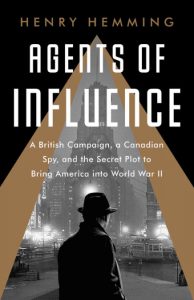Agents of Influence
In June 1940, American politics was divided into isolationists, who wanted to keep America out of the European war, and interventionists, who believed that America’s safety and prosperity depended on supporting Great Britain in its fight against Nazi Germany. In Agents of Influence: A British Campaign, a Canadian Spy, and the Secret Plot to Bring America into World War II, Henry Hemming, author of other real-life spy stories such as Agent M and The Ingenious Mr. Pike, tells the story of how Britain and Germany attempted to influence American politics from behind the scenes.
The story feels all too familiar in twenty-first century America: American organizations infiltrated by foreign powers, propaganda, demagoguery, false news. On the British side, businessman turned MI6 operative William Stephenson built a powerful intelligence operation from the 55th floor of the Rockefeller Center’s International Building. His people forged documents, planted false news stories, subsidized protest groups, and coached “Wild Bill” Donovan through the creation of their American equivalent, the Office of Strategic Services. On the German side, Hans Thomsen, chargé d’affaires at the German embassy in Washington, found ways to distribute Nazi propaganda, including a daring plan using congressional franking privileges, funded isolationist attendees at the Republican National Convention of 1940, helped grow the America First movement, and indirectly coached Charles Lindburgh’s increasingly strident isolationist speeches.
Hemming’s account of this shadow duel is remarkably even-handed, even when Hemming’ grandparents make a cameo appearance on behalf of Stephenson’s organization. No one had clean hands.
This review previously appeared in Shelf Awareness for Readers.





